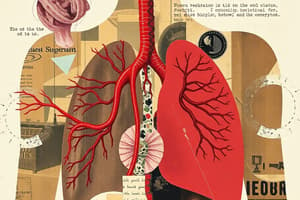Podcast
Questions and Answers
What is one of the critical aspects of circulation mentioned in the text?
What is one of the critical aspects of circulation mentioned in the text?
- Facilitating water removal from the body
- Digesting nutrients in the stomach
- Delivering oxygen to the cells (correct)
- Producing energy from glucose and oxygen
Which statement best describes the role of anaerobic respiration?
Which statement best describes the role of anaerobic respiration?
- It involves the breakdown of glucose into lactic acid. (correct)
- It primarily occurs in the presence of oxygen.
- It produces more ATP than aerobic respiration.
- It is a more efficient process for generating energy.
Where does the electron transport chain, a key component of aerobic respiration, take place?
Where does the electron transport chain, a key component of aerobic respiration, take place?
- Mitochondria (correct)
- Cell cytoplasm
- Cell membrane
- Nucleus
Which type of respiration occurs when oxygen is in limited supply?
Which type of respiration occurs when oxygen is in limited supply?
How does circulation help in body temperature regulation?
How does circulation help in body temperature regulation?
Flashcards are hidden until you start studying
Study Notes
Life Processes: Circulation and Respiration
The realm of life spans beyond the visible organisms that surround us, encompassing a myriad of intricate processes that keep these living entities functioning and thriving. Today, we'll delve into two essential life processes, circulation and respiration, to uncover how these processes sustain life at the most fundamental level.
Circulation
Circulation refers to the continuous movement of blood, nutrients, gases, and waste products within an organism. It is primarily governed by the cardiovascular system, which is composed of the heart and blood vessels. The heart pumps blood throughout the body, circulating it through three main loops: the pulmonary circuit, the systemic circuit, and the portal system.
The pulmonary circuit transports deoxygenated blood from the heart to the lungs, where it releases carbon dioxide and absorbs oxygen. The systemic circuit then carries oxygen-rich blood throughout the body, delivering oxygen and essential nutrients to cells while removing carbon dioxide and other waste products. Finally, the portal system circulates blood to and from the liver, facilitating the metabolism and detoxification of various substances.
Circulation plays a pivotal role in maintaining homeostasis, the body's ability to regulate its internal environment. Some of the critical aspects of circulation include:
- Nutrient transport: Blood transports essential nutrients and waste products to and from cells, ensuring that the body receives the necessary materials and disposes of waste products.
- Oxygen and carbon dioxide exchange: Circulation facilitates the exchange of gases between the body and the environment, allowing cells to obtain oxygen and release carbon dioxide.
- Body temperature regulation: Blood vessels near the skin's surface dilate or constrict to regulate body temperature by releasing or retaining heat.
Respiration
Respiration is the process by which an organism transforms oxygen and nutrients into energy, carbon dioxide, and water. There are two types of respiration: aerobic and anaerobic. Aerobic respiration occurs in the presence of oxygen, while anaerobic respiration does not.
The primary site of aerobic respiration is the cell, where glucose and oxygen are combined to produce energy in the form of adenosine triphosphate (ATP). The process involves three main stages:
- Glycolysis: Glucose is broken down into two molecules of pyruvate, and a small amount of ATP is produced.
- Citric acid cycle (also known as the Krebs cycle or TCA cycle): Pyruvate is converted into acetyl-CoA, and a series of chemical reactions occur in the mitochondria. This cycle generates a substantial amount of ATP.
- Electron transport chain: Electrons are passed from molecule to molecule in the mitochondria, creating a proton gradient across the inner mitochondrial membrane. This gradient drives the production of ATP through a series of enzymatic reactions.
Anaerobic respiration occurs when oxygen is not available or in limited supply. During anaerobic respiration, glucose is broken down into lactic acid, producing less ATP than aerobic respiration. For example, during intense exercise, muscle cells may switch to anaerobic respiration to generate ATP rapidly.
In summary, circulation and respiration are fundamental life processes that sustain life by delivering oxygen and nutrients to cells, facilitating cellular metabolism, and removing waste products. These processes are interconnected, with circulation enabling respiration and respiration influencing circulation, maintaining a delicate balance that allows life to thrive.
Studying That Suits You
Use AI to generate personalized quizzes and flashcards to suit your learning preferences.




